Q&A – Ask Neil: June 5, 2025
(Please read these instructions carefully.)
Before you post your question, please look at recent issues to see if someone else has already asked it. You might find your answer there.
How to submit your question…
(Note: You may need to allow a pop-up window to come up in order to get the link for sending your photo(s). If you have already submitted your question and didn’t see the pop-up window, please click here.)
• Click the link provided below to post your question. After you submit your question, a new window will pop up giving you the address to which you can e-mail a SHARP, HIGH-RESOLUTION PHOTO to accompany your question. Please DO NOT SEND THUMBNAIL PHOTOS in case I need to zoom in to see things.
• Click here to post your question.
• Please ONLY POST YOUR QUESTION ONE TIME. We can only accept a set number of questions each week, and when we get duplicates it costs other people their chances.
• One question per reader, please.
• Please use this only for posting questions – not for standard emails.
• Watch for your answer in the following week’s e-gardens.
• I choose those of greatest general interest. For example, plant IDs seldom make the cut.
• I must have your first name or initials.
• I must have your city or county. (Texas is a very large state.)
QUESTION 1
WHY ARE MY CRAPE MYRTLES LOSING THEIR FLORETS?
Question: Why are my established crape myrtle trees losing their florets this year – in the spring? I’ve noticed it happening all over our area. The trees don’t have any bark scale or sooty mold. No black spot or any other problem indicators. Carol Z., Highland Village, Denton County.
Answer: I work with crape myrtles a couple of days each week. Also, we live just east of you (meaning our crape myrtles are on about the same schedule as yours). Since you didn’t attach any photos, I can only assume you’re talking about plants that have shed their spent blooms after a week or so of flowering. That’s been quite common this spring because of the strong winds.
Several varieties, most notably the very popular Natchez (white) and Muskogee (lavender/pink) started flowering in northern parts of DFW three weeks ago and are already through with their first rounds of blooms. That’s all been completely normal. They will soon be producing buds for the next blooms in the sequence. Most other varieties are just now starting to open their first main rounds of blooms. A few others will be even later.
That answer is based on many years of hearing that question and watching crape myrtles operate. I think it’s probably accurate.
QUESTION 2
WILL THE MAGNOLIAS RUN OUT OF SPACE?
Question: The new development close to where I cycle is using magnolias as a hedge row. Is this a good idea? I’m from L.A. and even the small ones get big enough to need more room than these have. Steve C., Bedford.
Answer: I would agree with you. Even if it’s one of the dwarf types (Teddy Bear, or especially Little Gem), they should have had them much farther apart. They’ll look great for a while, but they’ll want to dig out every other one before too many more years. Tall hollies like Nellie R. Stevens would have been much better. Perhaps there was some thinking we don’t know about.
(They need to re-set and straighten the live oak while they’re at it.)
QUESTION 3
WHAT IS WRONG WITH THE ONE GIANT LEOPARD PLANT?
Question: We have six giant leopard plants. Five are doing fine, but one looks sick. They were all planted in February 2023. They are in shade of large trees, and we have a smart controller for our sprinkler system. Any ideas? Dan M., Richardson.
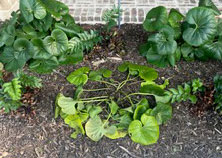
Answer: I tried to zoom in on your photo but the resolution wouldn’t allow me to see what I wanted to look at. I am guessing that the smart controller isn’t letting the system run often enough and/or long enough to soak the soil in the front of the bed. Leopard plants, especially the giant type, need copious amounts of water to sustain those huge, succulent leaves. It even looks like the front soil might have been dry at the time the photo was taken. (Notice how it is a different color.) Also, leopard plants need highly organic planting soil like you would prepare for hostas, ferns, and other shade lovers. I’m not seeing that, I don’t believe. Those would be my guesses.
QUESTION 4
WHAT IS GROWING IN MY GRASS?
Question: Please help me identify what is growing in my yard. This is in random places throughout my front yard. I have St. Augustine grass. The mystery plant barely breaks the top of the soil and hasn’t grown since I first noticed it several weeks ago. I’ve attached several photos. Lauren B., N. Richland Hills.
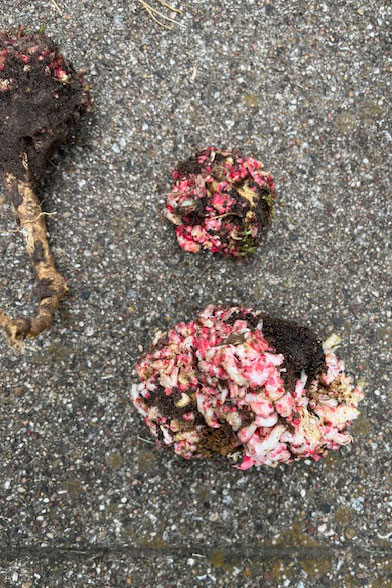
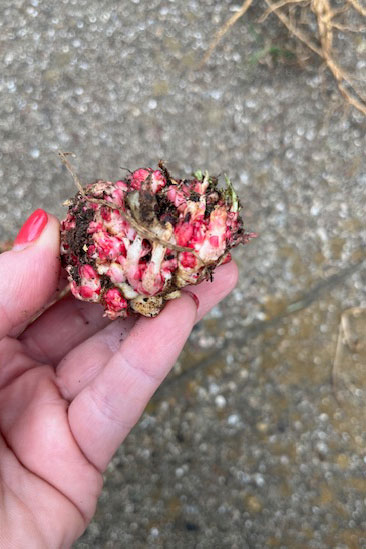
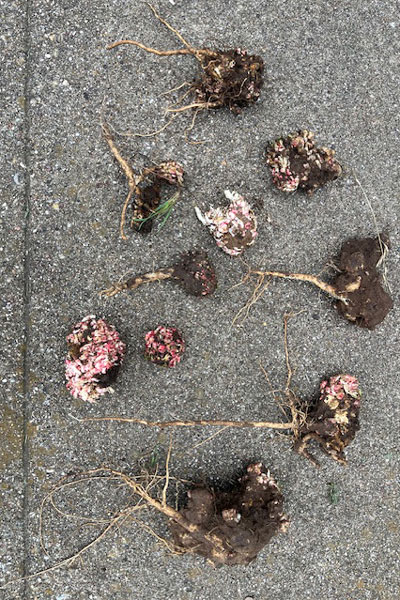
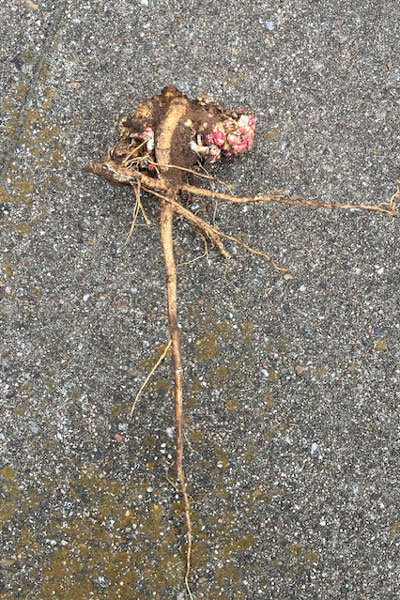
Answer: I will first confess that this did not look familiar, at least not in this form. I looked at all your photos carefully and finally decided to put them through Chat GPT to see if that could get the engines started. While occasionally it does go spinning off toward Mars, it has many times dug out some intricate little details that proved to be very helpful.
In your case, there were so many photos that the free version wouldn’t handle it, so I bit the bullet and signed up for the paid subscription. I’m sure I’ll get good use out of it. Here was its detailed reply that came back within 8 or 10 seconds after it looked at three of your photos. (I told it the photos had been taken in North Richland Hills.)
The unusual pink-and-white root growths in your photos are root nodules caused by a Rhizobium infection, and the plant they are attached to appears to be crown vetch or possibly another leguminous plant (like a type of vetch, clover, or similar species). These nodules are a sign of nitrogen fixation, a beneficial symbiosis where Rhizobium bacteria convert atmospheric nitrogen into a usable form for the plant.
However, these particular nodules are extremely swollen and possibly abnormal, potentially due to:
• Crown gall disease (caused by Agrobacterium tumefaciens) if the nodules are hard and tumor-like.
• Root-knot nematodes, which can also cause distorted root structures.
• A normal but highly prolific root nodule formation, especially in rich soil with lots of Rhizobium bacteria.
To summarize:
• If they are soft and pink inside: Likely nitrogen-fixing nodules (normal).
• If they are woody, malformed, or not easily broken: Possibly a disease like crown gall or a nematode infestation.
If I were in your situation I would look closely to see if these are associated with a particular type of plant growing in your yard. Crown vetch is a sprawling legume with compound leaves and pink flowers. There are other types of vetch, clovers, and even sensitive briar with the leaves that close when they’re touched. All of these plants would fit into the category that was being described. All could be hosting nitrogen-fixing bacteria, a very natural occurrence.
Then I would examine the nodules as described in the summary to see if they are soft and pink or hardened and malformed.
If you have questions beyond that you probably will want to send actual samples to the Texas A&M Plant Disease Clinic in College Station. If they suspect root knot nematodes, they may also want samples of the soil.
You presented a very interesting question and one that I don’t believe I’ve ever had before quite like this. I hope I have helped.
QUESTION 5
WHAT IS HAPPENING TO MY CANYON CREEK ABELIAS?
Question: What is happening to my Canyon Creek abelias? They seem so yellow. What should I be doing to help them? Susan S., North San Antonio.
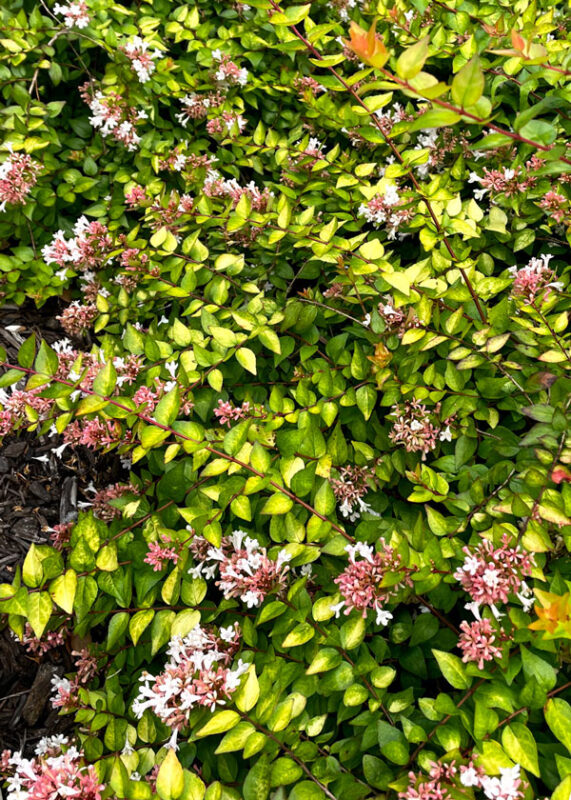
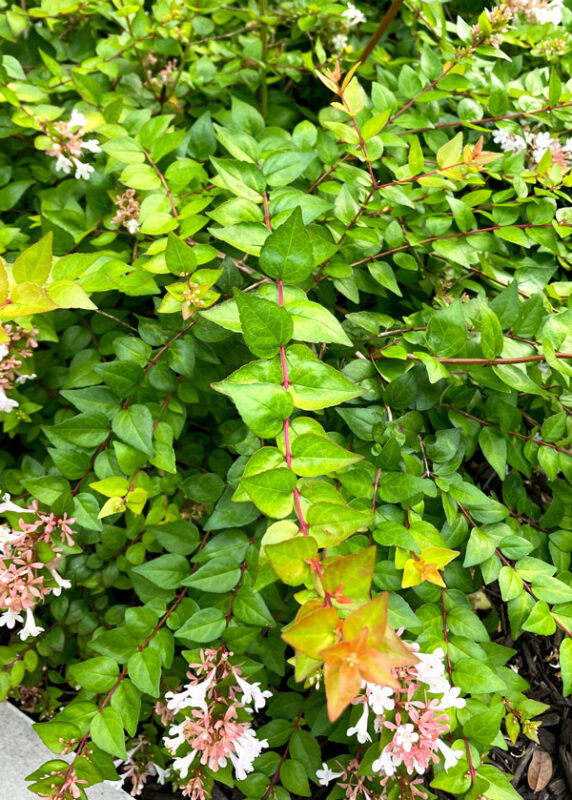
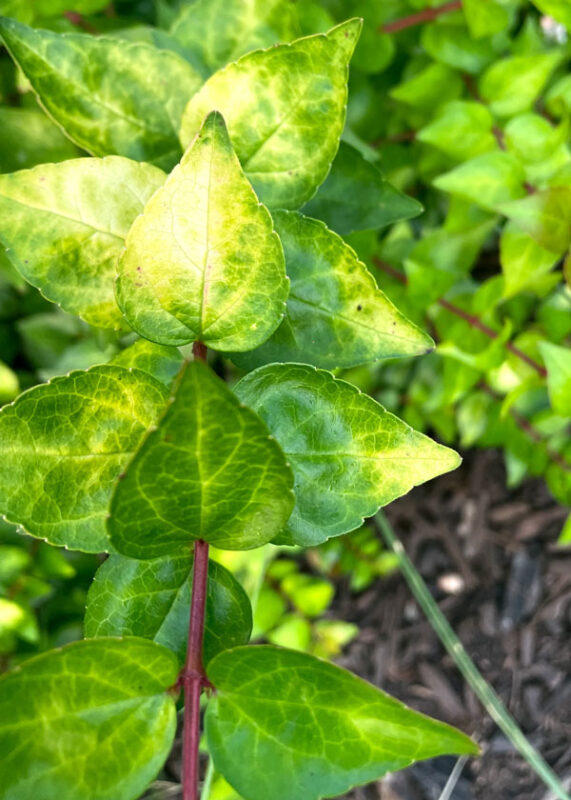
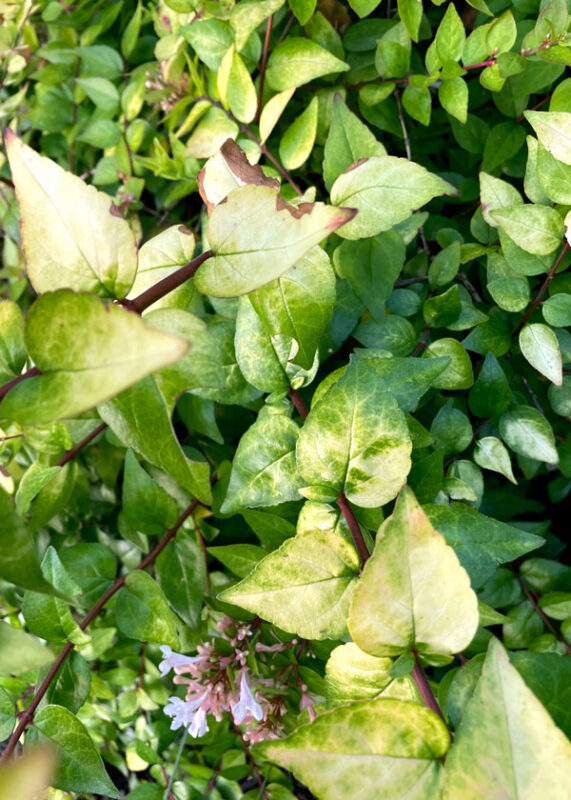
Answer: Susan called my radio program this past weekend. As we spoke, I realized I really needed to see photos of her plants. We arranged a special way for her to get them to me. I mentioned on the air that I would answer here so that all listeners would also be able to see my reply. The photos are excellent. So here are my thoughts.
First, as I mentioned to Susan on the air, I have not grown Canyon Creek, so I have no first-hand experience of watching it. There are several relatively new types of abelias that have come into the marketplace, and they all act differently.
If you look up Canyon Creek you’ll see many nurseries offering it. The common thread through their descriptions is that the plants’ foliage changes through the seasons, so some of this variation is to be expected. I believe Susan said that this is her plants’ second year in her landscape. Color shifts like this become much more noticeable on new growth, so that may be a good bit of it.
I note that this is not normal iron deficiency. Its key symptom is yellowed leaves with the veins remaining dark green the longest (just the opposite here), most prominently showing on the newest growth on the ends of the branches (not the case here).
This could be magnesium deficiency, also brought on by the high pH of the San Antonio soils and water supply. I would suggest trying a mixture of 1-2 tablespoons of Epsom salts per gallon of water poured as a soil drench around each plant every couple of weeks through the summer. See if that makes any difference. You might also put a soil acidifier (sulfur) to work at the same time. Avoid high-nitrogen fertilizers that would stimulate new growth as well.
Watch plants at the nursery where you bought these to see if they also experience the same color shift. Hopefully you bought from a local independent retail garden center where you can talk to a Texas Certified Nursery Professional.
QUESTION 6
DO I NEED TO APPLY IMIDACLOPRID AGAIN?
Question: I applied Imidacloprid as a soil drench around my crape myrtles on Sunday, May 25. The next day we had a 3-in. rain. Do I need to reapply it, or will it still be active? Jim O., Arlington.
Answer: You are probably good to go. The only thing that would worry me would be if you had so much rain that there was heavy run-off. To be safe you could always retreat, but I know it’s not inexpensive. I have to let you make that call. I would probably feel safe in not treating again.


